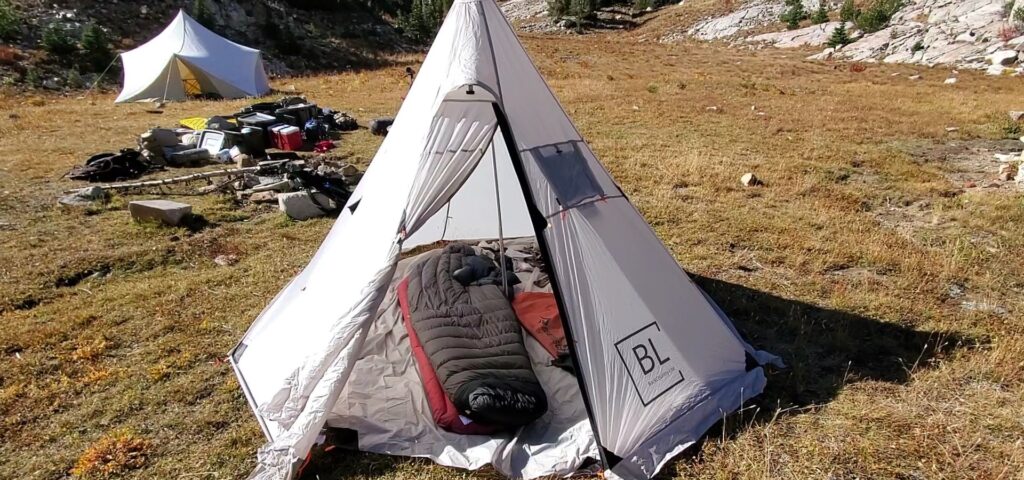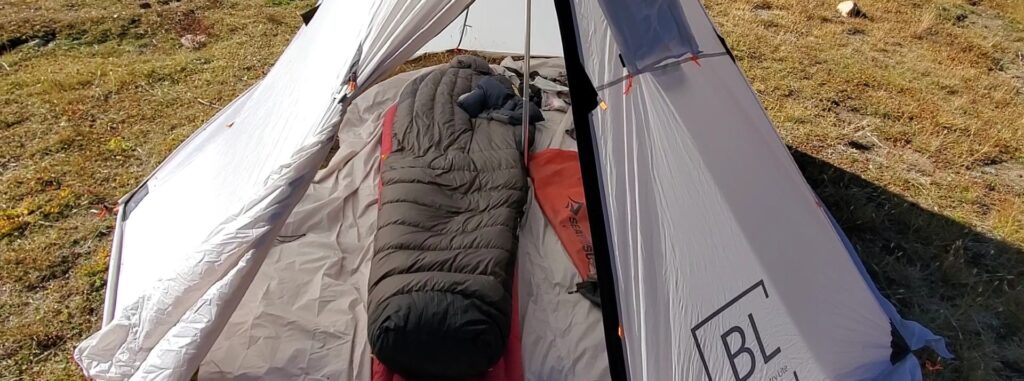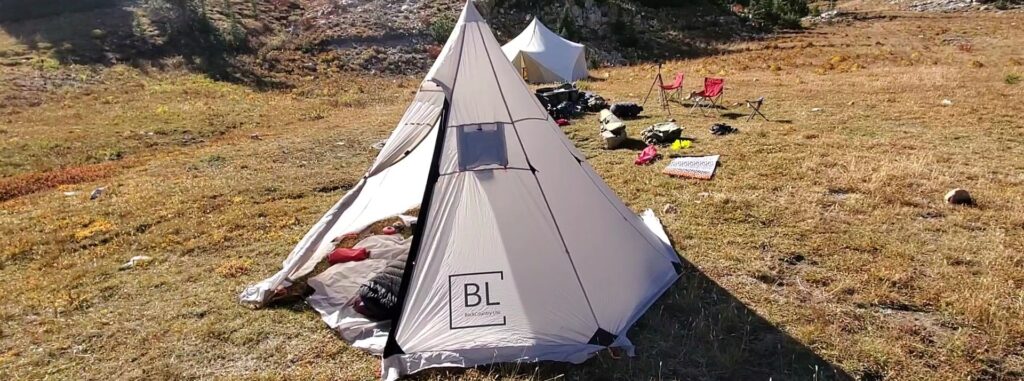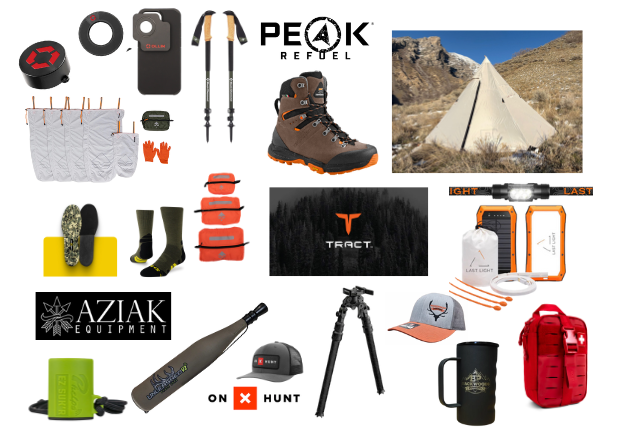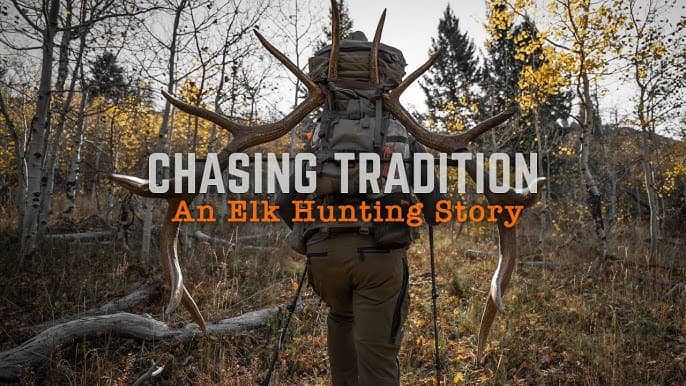The introduction of backpacking hot tents, like the Backcountry Lite Mesa Tipi Tent, is a game changer for folks who like to do winter or cold weather backpacking. I’ve been backpack hunting since I was a kid where all I had was an old frame pack, a sleeping bag, a tarp, and a teapot for cooking and warming up water for the top ramen. Tuna and crackers were a staple on these weekend trips. Fast forward to today, with the addition of ultralight stoves like a JetBoil and a wide range of freeze dried backpacking food on the market, backpacking has changed considerably.
For me, it’s always been about being outdoors, spending time with friends, and exploring new areas. I constantly look for ways to improve my equipment and lighten my load as I gain more knowledge about backpacking and hunting.
How I Tested It – Backcountry Lite Mesa Tipi Review
This year, I had the opportunity to test the Backcountry Lite Mesa Tipi on a number of trips ranging from September and October in the Eagle Cap Wilderness of Oregon, to late October in the high alpine mountains of Utah, as well as November in the Sawtooth Peaks of Idaho. I needed a tipi that was lightweight, easy to set up, and could provide a quick getaway for two guys on a backcountry hunt.
I spent ten days in the Eagle Cap Wilderness at an elevation of 9,000 feet where temperatures regularly dropped below freezing. More than half of these late September and early October mornings gave us frost to deal with. Additionally, I spent another week at the end of October in Utah participating in a high alpine mule deer hunt at elevations ranging from 9,000 to 10,000 feet, which also provided challenging sleeping conditions.
Make sure to check out our other gear reviews and the Backwoods Pursuit YouTube Channel to help you decide what gear will help you stay out in the field longer!
During my testing, I used the tipi without a stove and included a bivy sack along with my sleeping bag in late October to evaluate the tipi’s ability to retain warmth and block the wind. In Utah, temperatures consistently fell into the 20s during that week, with some nights dipping into the teens. Overall, the tipi performed well under these conditions.
Features – Backcountry Lite Mesa Tipi Review
The Backcountry Lite Mesa Tipi is a 3-4 person tipi tent featuring a stove jack that converts it into a hot tent for those times when the temperatures dip. If you’ve not used a hot tent, they are a game changer and the pinnacle of backcountry luxury during late season backpacking.
The Backcountry Lite Mesa Tipi Tent combines a traditional design of a tipi tent and adds in a stove jack to give you the versatility you need for just about any backcountry trip. It can be used for everything from summer to late season cold weather trips where a heat source is required. However, the versatility is one of the key features of this Backcountry Lite Mesa Tipi.
Here are some additional key features:
- Accommodates 3-4 people without a stove or 2-3 people with a stove
- 6’3″ peak height
- Spacious door opening
- Snow skirts (removed on Gen 2 model)
- Stove-jack with cover
- Aluminum pole
- Two sets of stakes
- Guylines
- Tent bag
One of the unique features of this Backcountry Lite Mesa Tipi is the optional floor. The ability to install the floor while still utilizing the stove helps keep the inside of your tent clean and dry. The spacious interior comfortably accommodates two people with the stove, or four without the stove, making it a castle on a solo trip or a trip with a friend (in relation to most backpacking tents). If you go with a larger group (up to four people) and split the tent among the group, it makes this tent very economical to use for a group (as long as you don’t mind sleeping in the same tent as your friends).
When the temperatures drop and a heat source is needed, converting the Mesa Tipi to a hot tent is fast and easy by pulling the stove jack cover back and installing the Backcountry Lite ulTIstove Titanium Stove. If you’ve ever been in the backcountry and needed to dry your clothes or get warm after a long day in the field, the heat source of the stove is an absolute game changer and can keep you in the backcountry when you otherwise might be sent packing for home.
Specs – Backcountry Lite Mesa Tipi Review
The Backcountry Lite Mesa Tipi weighs in at just over 3 lbs. (minimum weight without the floor), making it packable for backcountry late season adventures. Of course, if you add in the floor, you’ll add considerable weight, but that’s optional. I also found it easy to set up, and despite its lightweight design, it offers plenty of interior room, particularly for a packable hot tent.
Here are the Backcountry Lite Mesa Tipi specs:
| Component | Weight |
|---|---|
| Canopy Only | 3 lbs 5 oz |
| Floor | 1 lbs 8 oz |
| Aluminum Pole | 15 oz |
| Stakes – Titanium | 4.4 oz |
| Stakes – Aluminum | 5.4 oz |
| Dimensions | 10′ x 10′ |
| Height | 6’3″ |
| Doors | 1 |
| Approximate Total Weight: Canopy, floor, center pole, stakes. | 6lbs 1oz |
| Approximate Total Weight: Canopy, Stakes, Center Pole, w/o floor | 4lbs 9oz |
Materials – Backcountry Lite Mesa Tipi Review
The Backcountry Lite Mesa Tipi Tent is made from 40D ripstop silnylon with a hydrostatic rating of 3000 mm. As noted before, this is more robust than your typical “ultralight tipi,” but you also get added durability because of that. Some may still opt to save some weight and go with a lighter 20D fabric that tipi tents like the Argali Absaroka 4P and Seek Outside Cimarron 4P offer, but this Backcountry Lite Mesa and its 40D silnylon are notably more robust.
Warranty – Backcountry Lite Mesa Tipi Review
Backcountry Lite offers a lifetime manufacturer’s warranty which covers manufacturing defects, reflecting their commitment to quality and ensuring your tipi tent with stove jack is built to last through countless adventures and memorable experiences. While I didn’t have the need to use the warranty during my testing, it’s nice to know that if I have a problem, it’ll be covered.
Durability – Backcountry Lite Mesa Tipi Review
The Backcountry Lite Mesa Tipi tent is constructed from durable 40D ripstop silnylon. For those of you that have done some research, a more common fabric weight of 20D silnylon is used to shave some weight. However, the 40D silnylon provides more protection from strong winds as well as better heat retention for those winter conditions that can hit you in the face in the backcountry. This more robust fabric makes it a solid choice when the weather turns on you, but you do pay a weight penalty in return.
What I Liked – Backcountry Lite Mesa Tipi Review
I have been camping and hunting in Utah, Idaho, and Nevada, using various types of tents and tipis, and this is now one of my favorite tents. It’s easy to set up, even with cold hands, and simple to pack around when the time comes to throw everything in your backpack. I’ve taken it on a few backcountry trips around the Eagle Cap and Ruby Mountains, and it performed fantastically.
Price Point: Coming in at a much lower price than the competition, the Backcountry Lite Mesa Tipi allows folks to get into a lightweight tipi hot tent that might not otherwise be able to. Better yet, they are able to do this without sacrificing the quality of the tent.
Stove Compatibility: Even when temperatures dropped below freezing, it stayed nice and toasty inside thanks to the Backcountry Lite ulTI stove. There was more than enough space for my dog, Bullet, and all our gear to stay dry and warm. While not quite as lightweight as others on the market, the extra weight comes with the added bonus of additional durability. I highly recommend it.
Durability: The Backcountry Lite Mesa Tipi Tent is strong and durable, featuring a sturdy aluminum pole and tough fabric that kept me dry even in bad weather. Setting it up was easy, and it included everything necessary: a carry bag, two sets of stakes, guy lines, and a pole. Inside, there was ample space for my gear, and the design promoted good airflow and comfort.
Versatility: One of the standout features of this tent is its versatility. It provides adequate ventilation for warm nights, and it comes with a stove jack for use with their ultralight ulTI stove for those colder nights. Surprisingly roomy and comfortable, it accommodates taller individuals quite well.
- Price Point
- Hot tent compatible
- Durability
- Versatility
What I Disliked – Backcountry Lite Mesa Tipi Review
Stove Jack Position: The stove jack seems to be positioned too low on the tipi. I found this to cause some stability issues in higher winds which concerned me a bit. A position more towards the peak of the tent would provide better wind resistance and stability. At its current position, it tends to sway back and forth a bit too much for my liking if the wind picks up. Having witnessed some hunting buddies burn down their tent in the backcountry due to this exact issue, I’m especially sensitive to making sure the stove pipe is secure.
My other concern with the stove jack location is that the stove sits quite close to the tent fabric itself. While this isn’t an issue as long as the stove pipe remains where it’s supposed to, if the stove pipe is blown around by the wind and happens to come out of the coupling, you could have an open flame dangerously close to your tent fabric.
During my initial setup and test, this happened (without a fire going thankfully), because I had an 8′ stove pipe, and the wind pulled the stove pipe out of the coupling on the stove. Trimming the length of the stove pipe helped, but the amount of movement from the wind still made me nervous due to the location of the stove jack.
To help alleviate this issue, making sure the stove pipe is the proper length is critical, and securing the stove pipe using a wire provides additional peace of mind. A stove pipe that rests too far above the peak of the tent is more susceptible to wind, so I prefer the pipe to be no more than one foot above the peak of the tent.
Total Weight: There are always compromises, and we can’t have it all, but shaving some weight would be welcomed on the Backcountry Lite Mesa. As noted above, we’ve also covered the benefits of the heavier 40D silnylon that is used, so there is a tradeoff.
- Stove jack position is too low
- Total weight
Conclusion
During the last year of use and testing, I took the Backcountry Lite Mesa Tipi Tent on a number of hunting trips, and it performed exceptionally well in a wide range of conditions, temperatures, and uses. The tent is constructed with high-quality materials that are comparable to those found in more expensive tents, but it comes at a much lower price. The designers truly considered all the essential features needed for backpacking and camping and included them all.
Best of all, it’s significantly less expensive than other tents of similar quality, making the Backcountry Lite Mesa Tipi Tent an excellent choice. It’s made from quality materials, includes all the essentials, and offers an unbeatable value. If you want a top-notch tent without breaking the bank, this is the one for you. Prepare for incredible camping adventures with this tent by protecting you from the elements and keeping you in the backwoods longer.
Subscribe to Backwoods Pursuit to get Your FREE Backcountry Gear Worksheet!!!
Dial in your gear list, calculate your pack weight, and lighten up your pack with this handy tool!




